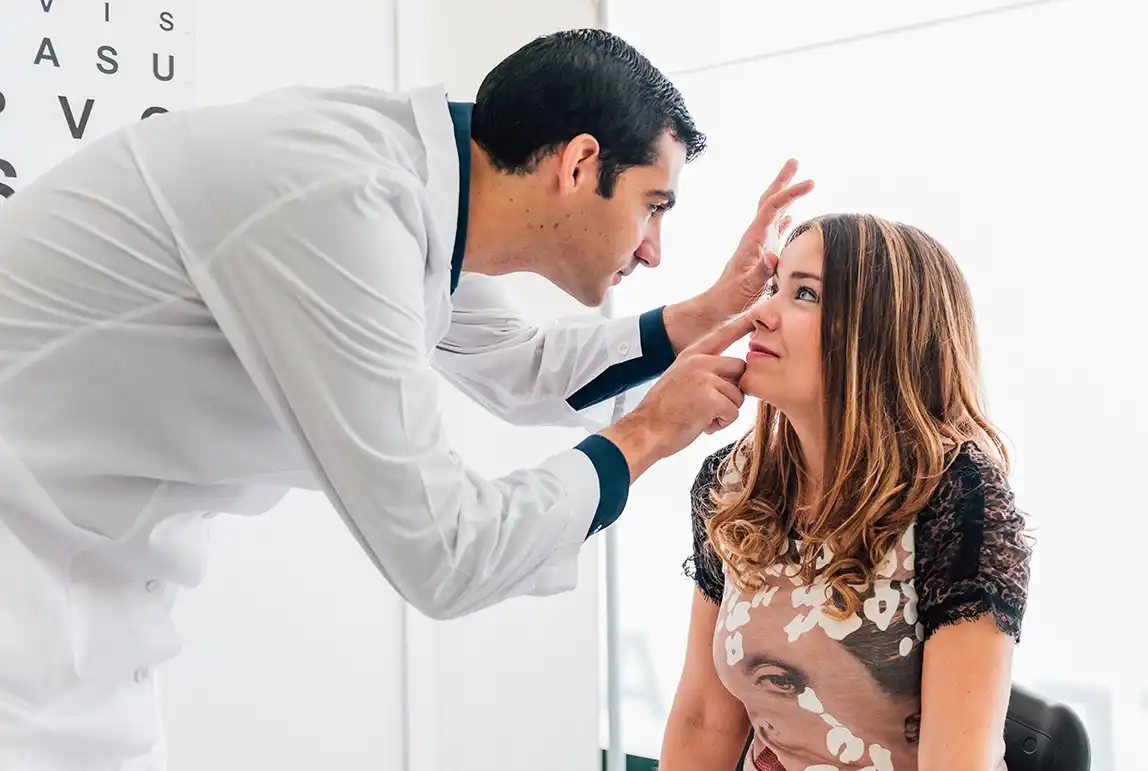PRK was the first vision correction surgery to gain FDA approval in 1995. Since then, millions of people around the world see more clearly thanks to PRK. At Southern Eye Group, our eye surgeons use PRK to correct nearsightedness, farsightedness or astigmatism, helping our patients in Alabama, Florida, Mississippi and throughout the Gulf Coast reduce or even eliminate their need for eyeglasses and contact lenses.
- What is PRK?
- What Does PRK Treat?
- Who is a Candidate for PRK?
- PRK vs LASIK
- PRK Surgery: What to Expect
- Preparing for PRK
- The PRK Procedure
- PRK Recovery and Results
- Frequently Asked Questions About PRK
- What is the cost of PRK?
- What are the risks of PRK?
What is PRK Eye Surgery?
PRK, or photorefractive keratectomy, is a form of outpatient vision correction surgery during which a laser is used to reshape the cornea to correct refractive errors. According to the
Trusted Source
What is Photorefractive Keratectomy (PRK)?
American Academy of Ophthalmology
Go to Source
American Academy of Ophthalmology
, many patients can reduce or even eliminate their use of glasses or contacts following PRK.
Did you know LASIK can help you save money on vision costs?
Learn more with our Savings Calculator.

What Does PRK Surgery Treat?
PRK Surgery treats refractive errors, which are irregularities in the way the cornea bends (refracts) light onto the retina. Refractive errors include:
- Myopia (nearsightedness): In the myopic eye, the cornea is overly steep or the eye is longer than normal. This causes light to refract onto the front of the retina and makes images in the distance appear blurry.
- Hyperopia (farsightedness): With hyperopia, the cornea is flatter or the eye is shorter than normal. Because of this, light refracts behind the retina and near images appear blurry.
- Astigmatism: In an eye with astigmatism, the cornea is irregular in shape. This can cause light to refract unevenly onto the retina, potentially affecting vision at all ranges.

Who is a Candidate for PRK?
PRK is a great alternative for patients who don’t qualify for LASIK because they have thin corneas or dry eyes.
Trusted Source
Photorefractive Keratectomy (PRK) Eye Surgery
Cleveland Clinic
Go to Source
Ideal candidates for PRK
:
- Are over the age of 18
- Have a stable vision prescription with no changes for at least one year
Have healthy eyes - Have realistic expectations for laser refractive surgery outcomes
PRK vs LASIK
When most people think of vision correction surgery, they automatically think of LASIK. During LASIK, an ophthalmologist creates a corneal flap before using an excimer laser to reshape the cornea and correct refractive errors. PRK is slightly different in that, while PRK also involves reshaping the cornea, the eye surgeon removes the outermost layer of the cornea (the epithelium) using an alcohol solution before reshaping with an excimer laser.
Patients who have thin corneas may not be good candidates for LASIK, but may still benefit from vision correction through PRK. PRK has a longer recovery time than LASIK, but research shows that both procedures have comparable patient
Trusted Source
A Comparison of Visual Outcomes and Patient Satisfaction Between Photorefractive Keratectomy and Femtosecond Laser-Assisted In Situ Keratomileusis
Hashmani N, Hashmani S, Ramesh P, et al
Go to Source
satisfaction rates.
PRK Surgery: What to Expect
Preparing for PRK
The first step of preparing for PRK is a thorough examination by an experienced ophthalmologist at our eye center. During this appointment, the eye surgeon will also review your medical history before deciding whether you are a good candidate for PRK.
Once your procedure is scheduled, a member of our staff will give you instructions to help you with preparation for and recovery from PRK. Please note that you will not be able to drive yourself home after the procedure, so you will need to make arrangements for transportation.
The PRK Procedure
While you can expect to be at our eye care center for a few hours on the day of your PRK surgery, the procedure itself only takes a few minutes.
Before PRK, your eye doctor will use anesthetic eye drops to numb your eyes and you may also be given an oral sedative to help you relax. A device will be used to gently hold your eyes open so you won’t need to worry about blinking.
To begin the PRK procedure, the ophthalmologist will use an alcohol solution to gently remove the outer layer of corneal tissue, called the epithelium. Next, the cornea will be reshaped using an excimer laser to correct refractive errors. You will be fitted with a temporary bandage contact lens to protect your cornea as the epithelial cells regenerate, as well as a temporary patch or shield. You’ll recover briefly at our practice before being driven home by a friend or family member.

PRK Recovery and Results
Recovery after PRK is slightly longer than the LASIK surgery recovery period because the corneal epithelium needs to regenerate. You will need to wear the bandage contact lens(es) for three to five days after PRK.
Patients can expect to feel some discomfort and light sensitivity during the PRK laser vision correction healing process. This should be easily managed with prescription and over-the-counter medications. You may also feel some grittiness, itching, or burning as your eyes heal and it’s advised to use the artificial tears frequently to help enhance your comfort. Please be careful not to rub or touch your eyes. Most of our patients return to work two to three days after PRK surgery, and resume non-strenuous activity within one to two weeks. During your follow-up appointment, your eye doctor will let you know when you can return to more strenuous activities.
Following PRK laser eye surgery, you should notice the full extent of your corrected vision within a month.
Frequently Asked Questions About PRK
Is PRK covered by insurance?
PRK is considered to be an elective procedure, which means that the cost of PRK is typically not covered by insurance. During your consultation with your ophthalmologist, you will learn more about the cost of PRK. To help each of our patients achieve clearer vision, we offer a number of convenient payment options for laser vision surgery.
What are the risks of PRK?
PRK has excellent patient satisfaction rates and is generally considered to be a safe procedure, especially when performed by an experienced and board certified ophthalmologist. Still, any surgical procedure does have some risk. Risks, complications, and side effects of PRK are rare but
Trusted Source
Main Complications of Photorefractive Keratectomy and their Management
Spadea L, Giovannetti F
Go to Source
may include:
- Infection
- Discomfort
- Glare or halo at night
- Decreased night vision
- Cloudy vision
- Double vision
- Dry eyes
- Corneal haze
- Over- or under-correction of refractive errors
Does PRK hurt?
Pain should not be a part of your PRK experience. Before the refractive surgery procedure, your eye surgeon will apply anesthetic eye drops to numb your eyes. You may feel some mild discomfort as you recover, but this will be easily managed with over-the-counter pain medications.
Is PRK permanent?
Yes, PRK permanently reshapes the cornea to correct existing refractive errors. However, the majority of adults encounter changes to their vision at around the age of 40 that make it more difficult to focus on objects up close. This age-related near vision loss is known as presbyopia and is a natural part of the aging process. At Southern Eye Group, we offer a range of treatment solutions for presbyopia.

Contact Southern Eye Group
At Southern Eye Group, we have helped countless patients in Alabama, Florida, Mississippi and throughout the Gulf Coast region achieve their dream of clearer vision. To learn more about PRK and find out whether you may be a candidate for laser vision correction surgery, please contact us to schedule a consultation.
1 American Academy of Ophthalmology. What is Photorefractive Keratectomy (PRK)?. Available: https://www.aao.org/eye-health/treatments/photorefractive-keratectomy-prk. Accessed June 1, 2022.
2 Cleveland Clinic. Photorefractive Keratectomy (PRK) Eye Surgery. Available: https://my.clevelandclinic.org/health/treatments/8596-photorefractive-keratectomy-prk-eye-surgery. Accessed June 1, 2022.
3 Hashmani N, Hashmani S, Ramesh P, et al. A Comparison of Visual Outcomes and Patient Satisfaction Between Photorefractive Keratectomy and Femtosecond Laser-Assisted In Situ Keratomileusis. Cureus. 2017;9(9):e1641. Published 2017 Sep 1. doi:10.7759/cureus.1641. Available: https://www.ncbi.nlm.nih.gov/pmc/articles/PMC5665689/. Accessed June 1, 2022.
4 Spadea L, Giovannetti F. Main Complications of Photorefractive Keratectomy and their Management. Clin Ophthalmol. 2019;13:2305-2315. Published 2019 Nov 27. doi:10.2147/OPTH.S233125. Available: https://www.ncbi.nlm.nih.gov/pmc/articles/PMC6885542/. Accessed June 1, 2022.
The doctors at Southern Eye Group have either authored or reviewed and approved this content.
Page Updated:


